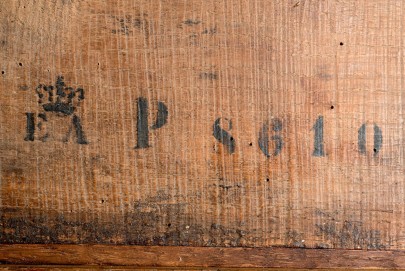Commode
Pierre Harry Mewesen
(Maître 1766)
France, period transition, about 1770
Oak corpus with fine marquetry of lozenges and flowers, engraved and partly colored, original lock and original fittings, stone top of "Brèche d`Alep"
stamped: «MEWESEN JME»
measurements: 63 cm x 35 cm x 80 cm
Prov.: Palais Penzing, gen. Palais Cumberland, Wien
Prince Ernst August of Hanover, 3rd Duke of Cumberland (1845 - 1923) crowned branding with Inv. No. EA P8610)
This French chest of drawers of the master Pierre Harry Mewesen radiates a reserved, solid elegance. A typical and high quality example of the "époche transition", the stylistic transition from Rococo to Neo-Classicism, it combines Late Baroque and Rococo elements with those, which already point to Neo-Classicism. The corpus in its stable, block-like form excellently complements the rounded and curved elements, notably those of the legs, which unite fast straightness and a graceful swing.
The cover plate is made of "Brèche d`Alep", a kind of marble known since antiquity and, in the 18th Century, was especially popular for furniture, also because it was quarried in France from 1712 onwards.
This piece of furniture comes from the Penzing Palais (aka Cumberland Palais) in Vienna (14. Penzinger Strasse 11-13), which George V., King of Hanover and 3rd Duke of Cumberland and Teviotdale, bought in 1868 after having fled to Austria two years earlier. Today the palais houses an Embassy. The Cumberland Dukedom has been established several times and was reserved for the younger members of the Royal Family. George V. of Hanover sided with Austria in the Austro-Prussian war, which led to the defeat of Hanover on June 29th, 1866. The king had to flee. This chest of drawers he either took with him or had it sent after him.
So this appealing piece of furniture has quite an eventful historical background.
Selection of Furniture
Commode Fireplace clock Table de Salon Commode Demi-Lune-Commode Table en chiffonnière Ladies-Voyeuse Banquette Louis XV Encrier Pair of Rococo-mirrors Table en chiffonnière Rococo-console Secrétaire à Abattant Pendule A Pair of Appliques Bureau Plat Commode Louis XV – Pierre Rousselle Satin? and amaranth tric-trac table Coiffeuse en forme de cœur A Set of four Fauteuils Commode Louis XV Tabouret Table Bouillotte et son Bouchon – Louis XVI Secretary A Pair of Fauteuils A Pair of Bergères A pair of Armchairs Bonheur-du-jour A Pair of Consoles



